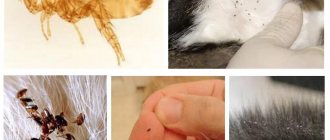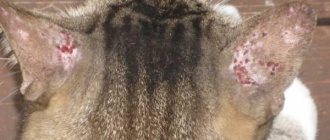Flea dermatitis is an inflammation of the skin caused by flea bites and an allergic reaction to their saliva. The severity of symptoms does not always depend on the number of parasites; sometimes one bite is enough for an intense pathological process. According to statistics, allergic flea dermatitis in cats is the most common cause of itching (up to 80% of cases). There is no pronounced seasonality, but most often the symptoms of the pathology occur in the summer and autumn.
Hypersensitivity to flea bites
Flea dermatitis is an allergic disease caused by flea bites. Proteins contained in insect saliva cause immediate or delayed consequences in the form of itchy irritation, scabs, and later bleeding scratches and wounds.
Many pets are susceptible to this disease, since the proteins in flea saliva are a very strong allergen. Flea scratches more often appear in cats that are free-range or live on the street, but domestic cats are not immune from them: fleas can be brought into the house on clothes or shoes.
Allergy to bites
Where do fleas come from in cats?
As it turns out, it is simply a myth that an indoor cat that does not leave the apartment and does not walk with outdoor cats cannot become infected with fleas. These parasites, in search of a victim, are quite capable of moving long distances on their own, even feeding on raids, without using an animal. Therefore, it can be difficult for owners to detect whether a cat has fleas.
The main causes of fleas in cats:
- from another infected animal;
- from you, you could bring a flea from the street on your own clothes;
- from a neighbor’s apartment or basement if you live in an old house or the neighbors do not process their animals;
- from your dog (yes, fleas are also transmitted from dogs to cats) who picked up a flea on the street.
– Fleas in animals are a very relevant topic, since most dermatological patients suffer precisely because of this problem. In veterinary medicine there is such a disease as atopic flea dermatitis - an allergy to flea saliva (2). It occurs in many patients and manifests itself as dermatitis and itching. This is also a problem because many owners believe that there cannot be fleas in their apartment or on their animal. Unfortunately, we do not live in sterile conditions and in residential buildings, especially if they are not new, fleas can live in basements, be in baseboards, or simply get from the entrance to the apartment. Both a walking animal and a completely domestic animal can become infected,” says veterinarian Marina Mikheenko.
Symptoms of fleas in cats
You can tell if your cat has fleas by the following symptoms:
- the cat began to itch frequently and for a long time;
- small wounds covered with a crust appeared on the cat’s skin;
- the cat began to sleep restlessly: what is called to scratch itself, jumps up in its sleep;
- the cat's appetite has decreased;
- When examining the fur, you can notice black dots - flea excrement, and you can also notice the insects themselves, which quickly move inside the hairs.
When fleas get on a cat's fur, they bite through its skin to feed on blood. This causes pain to the animal, flea bites itch, so the cat can not only scratch them vigorously, but also introduce an infection, turning the wounds into purulent abscesses. But the worst thing is that fleas are carriers of dangerous infections that can be fatal to cats. And the sooner you find fleas on your cat, the easier it will be to remove these dangerous parasites. By the way, although fleas do not live on people, they can bite them, so the owners are also at risk.
Types of flea dermatitis
Flea dermatitis is one of the most common feline skin diseases. Appears in the following varieties:
- spicy;
- subacute;
- chronic.
In acute dermatitis, the symptoms are pronounced, and the disease develops very quickly.
The chronic form is characterized by the appearance of areas of baldness and the appearance of small itchy nodules on the skin. Develops in the absence of proper treatment.
The subacute stage is a transitional stage. A characteristic symptom is a rapid onset, the onset of visible relief and subsequent exacerbation. This is a sign that the therapy was chosen incorrectly.
The main danger is complications arising from flea dermatitis. Atopic eczema may develop, which cannot be completely cured. There is also a risk of secondary purulent infections requiring antibacterial treatment.
Symptoms
The severity of symptoms depends on many factors: the age of the cat, its weight, the number of parasites and the general state of the immune system.
The first, most pronounced symptom is itching. The cat has very itchy wounds caused by scratching flea bites.
After some time, the hair begins to fall out, bald spots appear, the hairline becomes thinner, and ulcers appear on the skin.
The next stage is the appearance of scabs and crusts. The animal regularly scratches them, this causes suppuration, which indicates the addition of a bacterial infection.
The general condition of the cat worsens: weakness, lack of appetite appears, the animals meow loudly from itching and pain, and become very timid.
Diagnostics
The simplest diagnostic method before going to the vet is using a comb and a piece of paper.
First, the cat's fur needs to be well wetted. After this, the animal is placed on white paper and begins to be combed. A characteristic sign of flea infestation is the appearance of brown droplets on the paper. This color is the color of flea secretions. With extensive damage, living insects can also be seen.
To notice the presence of sores on the skin, you will need to part the fur and examine it with a magnifying glass. You may see brown spots, redness, and flea scratches.
A visit to the veterinarian is required: the doctor will conduct laboratory tests, perform scrapings and blood tests. This will help establish an accurate diagnosis based on the presence of antibodies.
A special allergy test may be required to identify the type of protein to which the animal’s body reacts.
Preventing skin problems in cats
Regular treatment for external and internal parasites is a prerequisite for the prevention of diseases in cats. In the warm season, it is especially important to protect your pet from fleas and ticks, and in some cases (warm climate, contact with stray animals, etc.) treatment should be year-round. You need to use safe products to which the cat is not allergic, and weigh the animals before treatment.
Healthy, well-groomed pets rarely become infected with fungal infections. Therefore, conditions of detention are important. In addition to protection from external parasites, the cat should regularly receive anthelmintic, be vaccinated in a timely manner, and for older animals an annual medical examination with blood tests is also relevant.
Balanced, nutritious feeding also helps maintain healthy skin and coat, regardless of whether you prefer natural food or commercial food. A healthy cat should have a “glossy” appearance and not suffer from year-round shedding, mats or dandruff.
Some diseases, such as autoimmune diseases or allergic reactions, cannot be predicted or prevented. In this case, the owner can do only one thing - promptly contact a specialist if the cat develops scratching or other skin problems.
Treating scratches at home
Self-medication for flea dermatitis is unacceptable, but primary therapy can be started at home.
the washing up
The animal is washed and treated with flea control. Fleas and their larvae are combed out with a fine comb. For prevention, after treatment, a special anti-parasitic collar is worn.
If there are bleeding wounds on the skin, they can be treated along the edges with iodine and tetracycline ointment. If there is pus, an antibiotic is needed - you cannot select it yourself - only on the recommendation of a doctor.
Important! To protect the animal from poisoning, all products must be thoroughly washed out of the fur. To avoid licking, you can use a special collar.
Scratch treatment
First of all, you need to remove the cause of itchy skin. Any veterinarian will tell you how to treat cats scratching on the neck and other areas of the body: you have to start with antiparasitic treatment. You should use modern means - they are effective and safe. You should not wash cats if you suspect a flea infestation - this is very stressful for cats, and bathing will not help get rid of parasites. If you wash off the natural fat layer from the skin, this will prevent the drops from being absorbed onto the withers, and it is the drops that most veterinarians prescribe for the treatment of parasitosis. It is painless for the cat and convenient for the owners.
Alcohol-based drops, such as Stronghold, are absorbed and evaporated very quickly - after just two hours you can stroke your cat’s fur. This is especially important if there are children in the house. "Stronghold" is convenient and has a wide weight range. If it is not possible to weigh your pet at a veterinary clinic, drops for cats weighing 2.6-7.5 kg are suitable for most adult animals.
After regular treatment with flea and tick drops, you can move on to further diagnostics, such as an elimination diet to detect food allergies.
Sometimes it takes a long time to conduct research and eliminate the problem, and you need to stop the painful process of itching as early as possible. Then antipruritic therapy is used.
Often owners are interested in what to anoint their cat’s scratches to speed up their healing. The choice of ointment depends on whether a secondary bacterial infection has developed after skin damage. You can use complex ointments with antipruritic, antifungal and antibacterial effects. But if the cat has scratches on its back, you will have to put a collar on the pet to prevent licking of the drug.
Omega-3 fatty acids, B vitamins (brewer's yeast) and trace elements such as sulfur and zinc contribute to skin healing. Fish oil, brewer's yeast or special vitamin-mineral complexes for skin and coat are added to the diet of natural-fed cats. If your cat eats commercial food, then it is enough to switch to a special diet to treat dermatitis.
Treatment
Your veterinarian will prescribe medications to treat flea dermatitis. The treatment regimen is as follows:
- relieving acute itching using antihistamines based on glucocorticosteroids;
- antiparasitic treatment, including the destruction of fleas and the use of preventive agents;
- treatment of secondary purulent infection with antibacterial agents.
The main requirement for treating cats is regularity. You should not take breaks in the use of antiparasitic drugs, as this may cause the disease to become chronic. When using antibiotics, it is unacceptable to complete the course before the time specified by the veterinarian in order to avoid the development of drug resistance.
Prevention of flea dermatitis
An effective means of preventing flea dermatitis is regular treatment of the animal with antiparasitic drugs or the use of flea collars. They should be used regardless of whether the cat goes outside, since flea larvae are carried indoors with the owners' shoes.
Regarding the diagnosis and treatment of flea dermatitis in cats in our clinic, you can contact veterinarians - dermatologists Oksana Anatolyevna Maykova, Ekaterina Sergeevna Novik
Use of anti-flea products
Flea medications are a mandatory stage of treatment. They are available in the form of external agents (drops, sprays and ointments). When using them, you should not wash the animal frequently, as this reduces the effectiveness of the medicine.
Another form of release is tablets. Chewable pills are well absorbed by cats and have a quick effect, being absorbed into the blood and destroying parasites. For preventive purposes they are used once a month.
Your doctor should advise you on how to treat your cat's scratching. You should not prescribe the drug and dosage yourself.
The procedure for making a diagnosis for skin problems in a cat
The veterinarian begins the appointment from afar - asks the owner about the conditions of the pet’s keeping, about nutrition, about changes in behavior. Only after this the specialist examines the animal. First, the doctor assesses the general condition of the skin and coat and pays attention to the location of the problem. So, scratching near the ears of a cat may indicate that the problem lies inside the ear. Severe itching is caused by otodectosis - ear scabies.
If lichen is suspected, Wood's lamp diagnostics is used. The skin and fur are examined under ultraviolet light in a completely dark room. Some fungal colonies will glow bright green. Even if there is no glow, a dermatologist can take a culture for the fungus.
Deep skin scrapings and microscopy are needed to detect subcutaneous microscopic mites in sarcoptic mange. But again, a negative scraping is not a sufficient basis to exclude the diagnosis.
In general, diagnosis in dermatology is complicated precisely because most diagnoses are confirmed empirically - the response to therapy is assessed. Some external parasites can be seen upon careful examination - haietiella, lice-eaters, fleas. But most often it is not possible to detect fleas. 90% of the flea population does not live on an animal, but is found in the environment. Those fleas that are on a cat cleverly hide in the thick undercoat and are often swallowed by licking and biting.
The dermatologist usually tells you how to treat your cat's scratching, and then begins to rule out the causes of itching one by one, starting with the most obvious ones. And the first recommendation is always treatment for fleas and other external parasites for at least three months.
Treatment with folk remedies
When choosing how to treat a cat’s sores, you can turn to auxiliary folk methods. They can provide an additional effect, but cannot 100% replace drug therapy.
The following alternative medicines have proven themselves well:
- wormwood oil (repels fleas due to its pungent odor);
- turpentine solution (in a dosage of 50 ml per 10 liters of water);
- a mixture of garlic and brewer's yeast (for treating beds, carpets and upholstered furniture where the animal sleeps).
Wormwood oil
If your cat scratches the bites a lot, you can use a weak chamomile decoction to wash it - it soothes sensitive skin.
Before using any methods, you should consult your veterinarian.
Prevention of dermatitis in cats
To prevent recurrence of the disease, appropriate precautions must be taken.
- It is better not to let the animal roam freely, and if it is not possible to keep it at home at all times, use an anti-flea collar.
- Contact with other animals is limited.
- It is recommended to take off your shoes when outside the home and wash the soles of your shoes with hot water and soap to avoid bringing in flea larvae.
- After contact with street animals, hands should be treated with an antiseptic or washed thoroughly.











